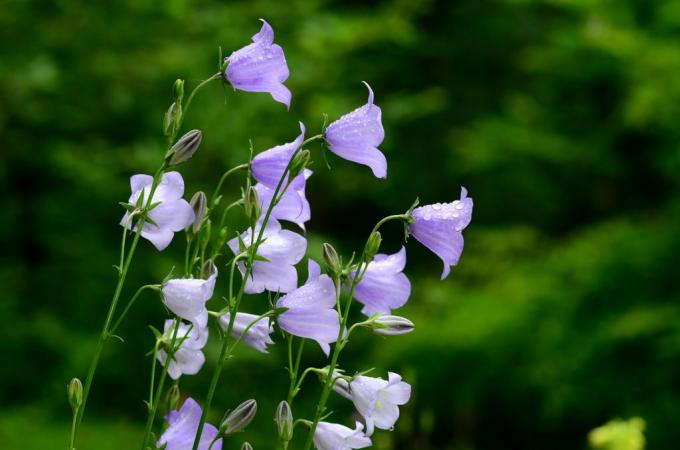The peach-leaved bellflower is a special species of bluebell. Here you can find out everything you need to know about the peach-leaved bellflower.

A native species among the bluebells (campanula) is the peach-leaved bellflower (Campanula persicifolia). Their blossoms bathe many flower meadows in deep blue or pure white.
contents
-
Peach-leaved Bellflower
- Peach-leaved bellflower: origin and properties
-
Varieties of the Peach-leaved Bellflowers
- Campanula persicifolia subsp. persicifolia
- Campanula persicifolia subsp. nitida
- Campanula persicifolia subsp. sessiliflora
- Plant peach-leaved bellflowers
- Caring for peach-leaved bellflowers: This is something to consider
Peach-leaved Bellflower
The peach-leaved bellflower is an extremely ornamental perennial. Since it also occurs wild in Germany, it is excellently adapted and uncomplicated to care for. The species sets beautiful accents in your own garden and is even suitable as a cut flower.
Peach-leaved bellflower: origin and properties
It occurs on wild meadows, on forest edges and on dry soil: the peach-leaved bellflower. With its beautiful blossoms, the native wild plant adorned gardens as early as the 17th century. Century so many cottage gardens. No wonder, because its large yet delicate white, blue or purple flowers are simply enchanting. It is variable in height and adapts to its location. So it stays at a size of 30 centimeters in the rock garden, while it can grow to 70 centimeters or more in a fresh meadow or at the edge of the forest. Since its home range extends from Siberia to Europe, it is perfectly adapted to our conditions. Since the peach-leaved bellflower is a perennial, it will sprout new inflorescences without any problems even after a winter at -30 °C. Its leaves remain green even through the winter.

Varieties of the Peach-leaved Bellflowers
Peach-leaved bluebells include several subspecies. In the following we present three different subspecies and their varieties with different advantages.
Campanula persicifolia subsp. persicifolia
Campanula persicifolia subsp. persicifolia is an excellent choice for your perennial border. The tall, slender inflorescences bear copious amounts of delicate flowers, while the narrow lanceolate leaves cover the ground. Some varieties of this subspecies are the following:
- ‘Grandiflora Alba’: The flowers of the 'Grandiflora Alba' variety appear large and bright white in June and July. It reaches a height of up to 80 cm.
- ‘Grandiflora Coerolea’: It is very similar to the 'Grandiflora Alba' variety in growth and appearance. Only the color of the flowers is different, because their flowers shine in a delicate blue-violet.
- ‘Blue Bloomers’: The breeding form 'Blue Bloomers' is exciting. As the name suggests, it bears blue flowers. What is special, however, is that these are half filled. Another bell with five leaves sits in the five-petalled bell flower. This variety also reaches a height of up to 80 cm.
Campanula persicifolia subsp. nitida
The varieties of the subspecies are small in stature Campanula persicifolia subsp. nitida. They are pretty in rock gardens and do well in very sunny spots. This subspecies comes in white as well as with blue-violet flowers.
- 'Alba': This compact variety only reaches around 20 cm in height - an ideal flowering plant for every rock garden. With its compact growth, the plant defies sun and drought and shows off its white flowers in May and June
Campanula persicifolia subsp. sessiliflora
The inflorescences of Campanula persicifolia subsp. sessiliflora. This subspecies is better known under the synonym Campanula latiloba.
- ‘Highcliffe Variety’: The purple-blue flowering variety makes a beautiful cut flower or border on fences.
- ‘Hidcote Amethyst’: This variety stands out due to its extraordinary flower color. In light pink, it forms an excellent accent to the typical blue-violet of many other bluebells.

Plant peach-leaved bellflowers
The peach-leaved bellflower feels at home in sunny and semi-shady places. Depending on the variety, however, there are preferences. The dwarf bluebells of the subspecies are particularly suitable for rather dry locations Campanula persicifolia subsp. nitida. All peach-leaved bluebells actually like it to be permeable and yet humus. Make sure the soil is neutral or slightly alkaline, meaning it has a pH of 7 or more. If the soil is too acidic, you should lime it to increase the pH.
Summary of planting peach-leaved bellflower:
- Sunny to semi-shady location
- Humic, well-drained soil
- Neutral to alkaline pH
Caring for peach-leaved bellflowers: This is something to consider
Fortunately, your peach-leaved bellflower does not require much care. Just give them some of ours when they start growing in the spring Plantura organic flower fertilizer with a long-term effect to provide her with all the important nutrients throughout the year.
That being said, your bluebell will do just fine on its own. From time to time, however, a little water can do no harm, especially in dry locations such as rock gardens. If you want to prevent the plant from seeding, you can remove the flower stalks before the seeds ripen.
More information about the bluebells you'll find here.



